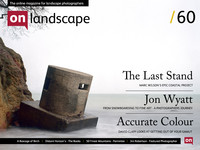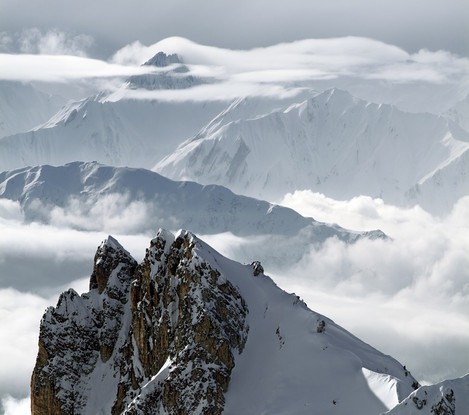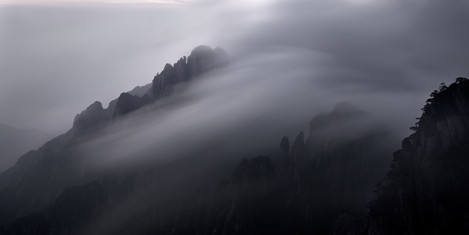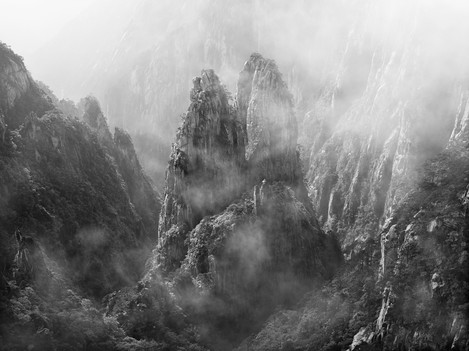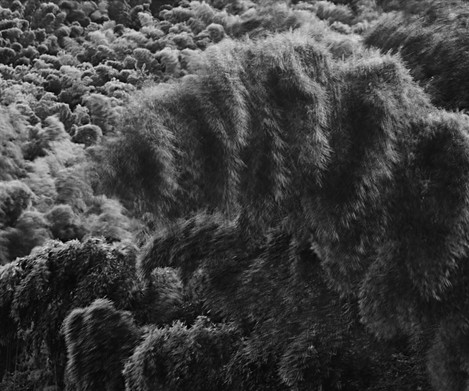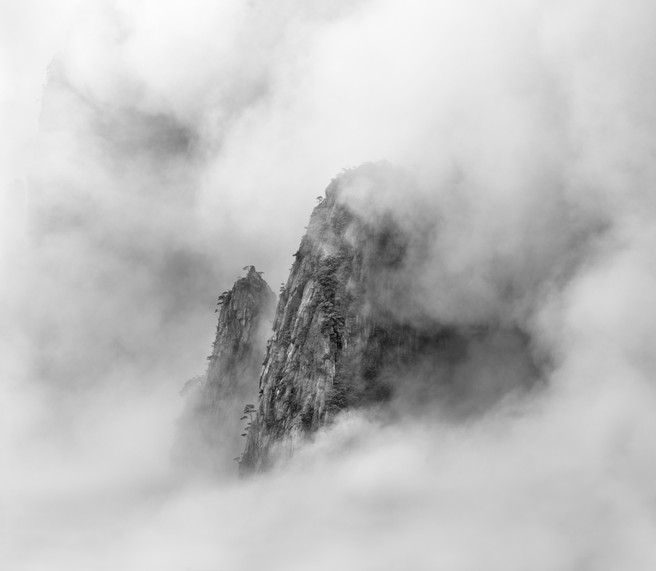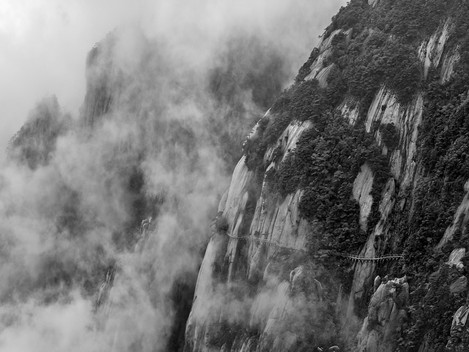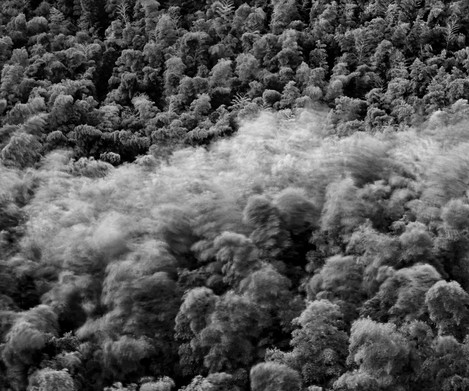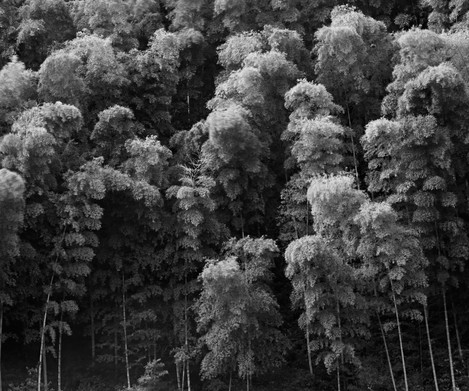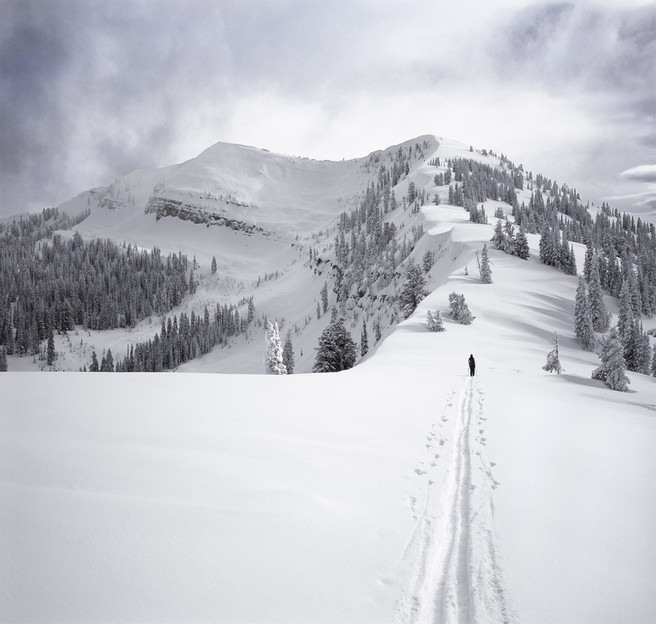From Commercial to Fine Art

Tim Parkin
Amateur Photographer who plays with big cameras and film when in between digital photographs.

Jon Wyatt
Jon Wyatt is a Cornwall–based photographer working on documentary landscape projects concerning environmental issues and landscape iconography.
A background in business and snowboarding helped Jon Wyatt create a successful business in photography but the move from commercial photographer to fine art photographer isn't the easiest. We catch up with Jon just before he goes off on a holiday/tour/sabbatical around the world and ask him how he got into photography and why the change to a 'fine art' approach.
Can you give us some background on how you got into photography in the first place?
After completing a business degree it took the prospect of a year’s hitchhiking round Africa to nudge me into buying my first film slr. 90% of the resulting shots were abstract cloudscapes or landscapes of the remote desert areas that I'd been particularly drawn to. Those shots subsequently formed the core of my first photography website - http://www.skyscapes.co.uk. I put together some portfolios and the several art consultancies liked the work enough to promote it. At the same time I was an extremely keen snowboarder, and as my friends & I sought out some new and relatively unknown snowboarding destinations they convinced me to take my camera up the mountain.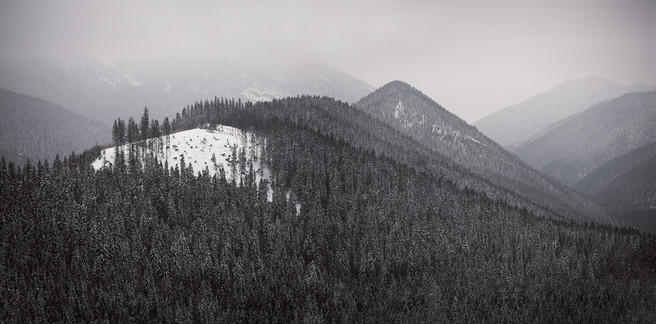 The companies we travelled and stayed with used some of the shots so I contacted some ski and snowboard companies and magazines and made more sales. I met some magazine staff writers and convinced them that i could illustrate more articles and after several years of making part-time photography/snowboard trips I turned full time freelance in 2003. I spent the next eight winters shooting editorial photography for ski and snowboard magazines and became known for working mainly in remote or unusual backcountry locations - editors would refer to them as 'aspirational' destination features. My photographic style tended towards shooting vast landscapes and panoramas with any skiers or riders usually small in the frame. Greenland, Kashmir and Alaska were particular highlights for me.
The companies we travelled and stayed with used some of the shots so I contacted some ski and snowboard companies and magazines and made more sales. I met some magazine staff writers and convinced them that i could illustrate more articles and after several years of making part-time photography/snowboard trips I turned full time freelance in 2003. I spent the next eight winters shooting editorial photography for ski and snowboard magazines and became known for working mainly in remote or unusual backcountry locations - editors would refer to them as 'aspirational' destination features. My photographic style tended towards shooting vast landscapes and panoramas with any skiers or riders usually small in the frame. Greenland, Kashmir and Alaska were particular highlights for me.
How did the transition from commercial work to a more project/art oriented approach happen?
It was a combination of several reasons really. I was based in the UK and flew everywhere, rather than some ski photographers who immerse themselves in one mountain area, and this eventually wore me down a little. After 9/11, flying with masses of photography and snowboarding kit had become much more complicated and expensive which didn't help, particularly with editorial budgets constantly tightening. But ultimately it was the rather instantly disposable nature of editorial magazine photography that made me reconsider my options.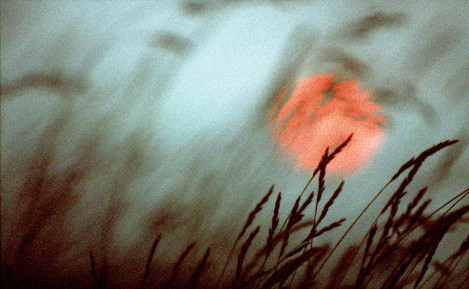
I'd been lucky enough to shoot in so many amazing locations and had become aware that each destination had many other issues beyond what I was shooting for the ski magazines. My visits were often (though not always) brief and I felt that there was so much more to say about those destinations. Whilst still shooting for ski magazines I was part of a studio collective in London with several photographers who were studying photography MA's and that's where I really encountered the critical project-oriented approach first hand. I knew I wanted to work on longer-term projects and felt I had something to say, but it wasn't obvious how to proceed - and I didn't have the money to do an MA!
The transition appeared to have happened overnight but I imagine there were a few struggles along the way. What was that period like?
Whilst I was still shooting commercial ski-related work I'd entered various competitions and had been lucky enough to win an AOP award aswell as regularly showing prints as part of quite a few joint exhibitions. The studio collective (Roof Unit) I was part of had a joint exhibition of work with Brian Griffin and I won the Best Pro Photographer at Kendal Mountain Film Festival which led to a solo exhibition at the festival the following year. At this stage I still had a portfolio full of mostly unrelated landscapes so I immersed myself in the London gallery 'scene' to find out more about how it worked. I quickly realised that I can easily become over-saturated with images if I see too many, the sheer volume of photography simply overwhelming. If I have an idea which I think might work as a project a 'google' will quickly reveal how many times its been done before and it's all too easy to then fall prey to feelings of 'everything's been done before'. The 'usual' advice - shoot what you know or shoot what you love - is still a great starting point but the best advice I've heard came from musician Brian Eno who said 'don’t spend your time shooting at other people’s targets. Shoot your own arrow and paint a target around where it lands…' I like this idea of 'creating' a market for your own work - and I guess I've quite stubbornly made the work I want to make despite hitting quite a few dead ends in its marketing. I've discovered my work can tend to fall between different stools - its been described as 'too beautiful' by some of the more experimental contemporary galleries who believe that this detracts from the message; and some of my 'darker' work is not exactly suited to more 'traditional' landscape galleries. It can be slow and often demoralising process as you come to realise that your photography won't suit everyone, and even the people who it appeals to, might still not know how it should be marketed.
You’ve attended a few portfolio reviews, how was your first experience of this and how do you think it helped your photography?
My first portfolio review was at Rhubarb Rhubarb in Birmingham (2010) and I took a portfolio of mysterious, quite abstract mountainscapes and landscapes. It was very much hashed together from previous work and it (mostly) got thrown back at me for the underdeveloped concept. However there were glimpses of hope - some reviewers loved some of the work, some of the themes and styles. Undoubtedly one of the best things about reviews is that they force you to examine your own work critically. And to brutally edit your own work as objectively as possible. You generally have 20 minutes with each reviewer but you need to explain your own work in 5-10 mins max so you want to spend the rest of the time listening to the reviewer. Even if they don't link the work - you need to understand why. And the reviewer will always suggest someone who they think will like the work! The reviews force you to be able to answer questions about the work you're showing - why did you shoot that, why from that angle, what are you trying to say and so on. From my own standpoint and the type of work I now produce I wanted to meet curators, collectors and gallerists. However, most reviews have a cross section of reviewers from the editorial and advertising/commercial fields as well as the contemporary market.
As I have done more reviews you learn that even if your own work is good, often reviewers don't know what to do with it, or where to market it or it is simply 'not their bag'. While choice of reviewer is important as you try to figure out where your work 'fits' in the market, it's often the reviewers you least expect to get something from who surprise you with great leads or advice. And you should build up contacts by seeing the same people again and again each time you bring out new work. Gallerists and collectors are interested in whether you will be around for the long haul, they want to see how your work develops, and if you can repeatedly produce good work. Reviews are very much a long-term investment - generally nothing happens instantaneously, the gallery world in particular generally moving very slowly. They are expensive so you should choose events carefully - use small, cheap local events to polish your presentation skills and portfolio content, and then focus in on the markets you want to get into. And there's a lot of markets out there beyond the UK - I've done larger review events in France (Les Rencontres d'Arles) and in Portland, Oregon (Photolucida) and I've been lucky in that they have both lead to gallery representation.
You’ve worked on a couple of projects in China, notably Huangshan Ltd and Bamboo (Six Seconds). How did the idea for these projects come about and how did you fund them?
In 2009 I moved to a rural area of Suffolk and spent some time developing a framework for my photography. That framework, or overriding theme if you like, is one within which all my subsequent projects have fitted. The idea behind it came about when I realised that though I’d spent none of my adult life in Devon, I still consider the westcountry, and in particular Dartmoor, my spiritual ‘home’. This made me query how cultures turn to the landscape for collective identification – creating a ‘homeland’ as it were. Memories and cultural virtues are projected onto the landscape, giving it a moral and spiritual significance - originally by storytellers, poets and painters but these days also by photographers. Increasingly I feel that the bond with our homeland, the link between a culture and its physical landscape, is deteriorating. In a nutshell, we now adapt our environment to suit our own ends, rather than allowing our environment to shape who we are - working against ecosystems rather than with them. In trying to illustrate this through photography I’m constantly searching for tools within the landscape that articulate this growing spiritual and cultural detachment. These 'tools' enable me to use landscape photography to express a documentary point of view.
A Chinese reviewer who had been at Rhubarb Rhubarb liked my work and commissioned me, along with several other UK and US photographers, to visit south-east China. Yangzhou is a small city (by Chinese standards) with a rich history which the city authorities wanted a selection of photographers to record for the production of new publicity material for the city. Once that was complete I extended my stay in China. I'd researched wilderness areas and had discovered an area called Huangshan - of which I knew very little yet whose landscapes seemed strangely familiar. It’s at that point that several strands of the project came together very quickly. Firstly I discovered the well-documented phenomenon of its ‘seas’ of cloud and, as I mentioned, I’m always looking for aspects of the landscape that allow me to articulate, in the imagery, a documentary point of view. I felt these mists could be the perfect tool and the project 'Huangshan Ltd' came about.
Huangshan, which means ‘Yellow Mountain’, turned out to be one of China's most iconic national monuments. A range of mountains consisting of 72 granite peaks, the ‘Mount Huangshan Scenic Area’ covers an area of nearly 120 square miles and has been declared a UNESCO World Heritage Site for its habitat for rare and threatened species. It’s one of China’s top tourist attractions, and spiritually and culturally its iconic status ranks it with the Yangtze River and the Great Wall. Huangshan’s beauty has inspired centuries of poets, scholars and particularly painters – perhaps the reason its gnarled pines and sheer granite walls seemed so familiar to me. Known to the Chinese as ‘the number one mountain under heaven’, it is a ‘sister’ national park of Yosemite in the US. 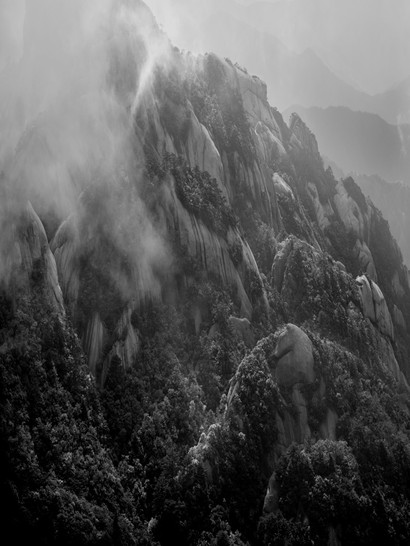 Yet the entire Mount Huangshan Scenic Area is owned and managed by one company, the ‘Huangshan Tourism & Development Company Ltd’ and is listed on the Shanghai Stock Exchange. China’s decades of rapid economic reforms and the unwillingness of central government to allocate money and resources to such areas has led to this process of privatization. It’s a model that is being widely replicated for other iconic spiritual and historic sites, from Shaolin temples to sections of the Great Wall.
Yet the entire Mount Huangshan Scenic Area is owned and managed by one company, the ‘Huangshan Tourism & Development Company Ltd’ and is listed on the Shanghai Stock Exchange. China’s decades of rapid economic reforms and the unwillingness of central government to allocate money and resources to such areas has led to this process of privatization. It’s a model that is being widely replicated for other iconic spiritual and historic sites, from Shaolin temples to sections of the Great Wall.
Whether this situation has ultimately been good or bad for the area involves an extremely complex set of arguments that I won’t go into here, but it was a situation that I wanted to gently draw attention to. And whether right or wrong, I felt the circumstances were indicative of our approach to other iconic environments – and it just didn’t sit right with me. I wanted to express this photographically - not by photographing the building sites and part-finished 5-star hotels high up in the Huangshan mountains but by showing the pristine landscape and using text to contrast and jar the emotions of the viewer. As I mentioned, the area's mists provided the perfect tool to illustrate my point. Witnessing first-hand the mists for which Huangshan is renowned – gossamer threads that drape the mountains and which periodically converge into dramatic ‘seas’ of cloud that surge and billow between the peaks - I knew that I wanted arrange the final images in such an order that would echo the natural process. If the images were seen in a book, or on a gallery wall, the cloud would appear to build up from one image to the next, eventually completely obscuring the landscape, before slowly dispersing again at the end of the series. I also knew from a previous series I’d made in the UK called ‘Avalanche UK’ which featured sites of fatal avalanches – in summer and devoid of snow - that by turning the images to black and white I could emphasise the textural nature of the granite cliffs, and focus the viewers attention on the encroaching clouds.
The project 'Bamboo (Six Seconds)' was shot on the same trip. It was an idea I'd had at the back of my mind for a year or two ever since I'd heard the fact that every six seconds fifteen acres of the planet are deforested - that's 60,000 sq metres, or six hectares, or nine football pitches.. In the same way as I had used the mists of Huangshan as a tool, I wanted to use six-second exposures to convey this deforestation fact. I discovered that to the Chinese bamboo holds iconic status, representing the harmony between nature and man – and symbolising civilisation. In myths, literature, calligraphy and painting bamboo’s characteristics embody the finest human virtues – integrity, humility and purity. And comparing a person to bamboo is considered the highest possible praise of their character. Armed with this information I could see that this project would fit ideally with my framework.
Bamboo is often touted as a miracle crop to counter deforestation, being one of the fastest growing plants on earth. Growing up to four feet a day, one hectare of bamboo sequesters sixty-two tons of carbon dioxide per year. Generating up to 35% more oxygen than an equivalent stand of trees, it can be used to produce everything from food, fabrics, paper, building material and oil. However, rising demand from the west has, ironically, brought new environmental concerns for bamboo forests. Increased use of unregulated pesticides for production plus the strong chemical solvents required to process the bamboo have poisoned watercourses and threaten precious animal habitat.
Indiscriminate harvesting has resulted in half the world's species of bamboo now being in imminent danger of extinction. Like Huangshan, the bamboo forest is another ecosystem steeped in iconography and cultural values, which finds its existence threatened, at the centre of a complex set of arguments which I hope to use my photography to gently draw attention to. And time (the six second exposure) was the tool that I chose to use.
You specialised in mountain sport photography, a very competitive market. How did you differentiate yourself?
As I hinted at in the answer to your first question I essentially thought of my work as shooting landscapes which just happened to have skiers and snowboarders in them, rather than thinking of myself as an 'action' photographer. Hence the figures tended to be quite distant. Often most of my work would take place in areas outside of regular ski resorts, usually accessed only ski-touring. This was the type of work I was drawn to and I felt that this approach matched the article texts which were often more about the landscape and destination than the skiing. Though I did push the format of the landscape approach to extremes, once presenting an art director of a traditional ski magazine with an assignment shot almost completely in panoramic format. And though I'd said he could crop in, to his credit he devised a layout combining three panoramas to each of several double page spreads.
Many of your mountain photographs show people as an almost insignificant part of the environment. Do you plan to include people in your future projects, even if only at a distance?
A lot of my work uses ways of disguising the scale of a landscape to deliberately create mystery and to, hopefully, intrigue the viewer. I'm striving for something innate in the image which creates an unsettling effect for the viewer causing them to question the image - to inquire more closely, and to suggest there might be more to the picture than initially perceived. I've found using figures in the landscape often negates these effects. The eye is usually drawn immediately to the figure, the viewer asking what must that person be seeing/feeling/experiencing. That's not what I want the viewer to be considering when looking at my images. Having said that, if any upcoming projects, that fit within my framework, call for this approach then it's certainly something I won't rule out.
Your taking a ‘sabbatical’ from commercial photography to concentrate on your art/project oriented work. Can you tell us a little about your plans?
Actually to be strictly correct I'm not taking a sabbatical from 'commercial' photography. I find that these days the contemporary market - dealing with galleries, exhibitions, art consultants, collectors etc - takes up more and more of my time, and hence results in a greater proportion of my income. So I've been doing far less 'commercial' work. My personal projects aren't 'personal projects' any more and instead they take up the majority of my time and are becoming more 'commercial' than the 'commercial' photography you're referring to in the question.
However, yes, I am taking a sabbatical with my partner for six months with some travelling in New Zealand, China and some of south east Asia. The timing is mainly to do with her changing jobs. We will, however, be visiting a couple of locations that could feature as part of my next photographic project, so I'll be packing a pared down Phase One kit!

